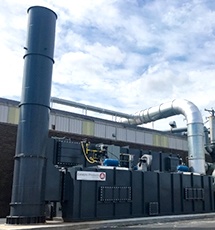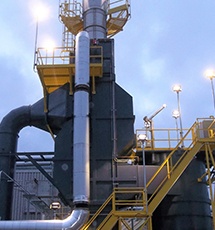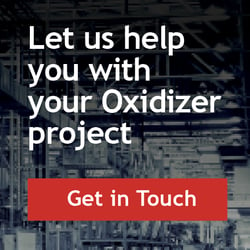In our recent blog, "What's the Best Air Pollution Control Technology for My Process?", we examined the many factors that can impact a facility's choice of air pollution control equipment. When they are considering their air pollution control needs, it is important for the plant's engineering staff to discuss the application data with potential suppliers. This data will provide crucial details about the process operation, including as uptime, maximum VOC loading, and maximum air flow. With this data, the supplier will be able to predict energy usage, permitted emission rates, and other process operation data that may be critical to equipment design, and with this knowledge, they will be able to recommend options that meet the requirements for Best Available Control Technology (BACT) or Maximum Available Control Technology (MACT), ensuring that the facility's engineering staff will be able to meet or exceed their environmental goals or outcomes.
Read More
Topics:
Air Pollution Control,
Regenerative Thermal Oxidizer,
Thermal Oxidizer,
Catalytic Oxidizer,
Blog
In our recent blog, "What's the Best Air Pollution Control Technology for My Process?", we took a look at the many factors that inform the choice of air pollution control equipment. When considering air pollution control needs for a facility, it is important for the plant's engineering staff to discuss the application data with potential suppliers. This data includes details about the process operation such as uptime, maximum VOC loading, maximum air flow, energy usage concerns, permitted emission rates, and other process operation data that may be critical to equipment design. Reviewing this data will help determine the available options that will be able to meet or exceed the facility's environmental goals or outcomes. With this data, the air pollution control equipment supplier will then be able to determine the appropriate Best Available Control Technology (BACT) or Maximum Available Control Technology (MACT).
Read More
Topics:
Air Pollution Control,
Regenerative Thermal Oxidizer,
Thermal Oxidizer,
Blog
In our previous blog, "What's the Best Air Pollution Control Technology for My Process?", we reviewed the many factors that impact the choice of air pollution control equipment. In situations where a facility is considering their air pollution control needs, it is important for the plant's engineering staff to discuss the application data with potential suppliers. Application data are the details about the process operation such as uptime, maximum VOC loading, maximum air flow, energy usage concerns, permitted emission rates, and other process operation data that may be critical to equipment design. This will help determine the available options that will allow them to meet or exceed their environmental goals or outcomes. The air pollution control equipment supplier will then be able to direct the customer to the appropriate Best Available Control Technology (BACT) or Maximum Available Control Technology (MACT).
Read More
Topics:
Air Pollution Control,
Thermal Oxidizer,
Blog
At Catalytic Products International, we have a great team of knowledgeable, dedicated professionals that bring years of experience to the work that we do in providing air pollution control solutions to our customers. Here on our blog, we’ve been speaking to some of these team members and sharing their insights with you.
Read More
Topics:
Air Pollution Control,
Maintenance and Repairs,
Expert Interviews,
Blog
Internet research and shopping has risen substantially over the past five years, and it will only continue to grow. Searching for a pizza place? Easy. You can customize and define your search by including “Chicago Style,” “Deep Dish,” or maybe “Gluten Free.” This will narrow down the results, helping you find what you asked for. This is a simple process, because you know exactly what you are looking for. You pick a restaurant, order your pizza, and maybe even write a review to help other shoppers find the perfect place to eat. Don’t get me wrong – the internet is fantastic! It is, however, limited to responding to the search terms that we input.
Read More
Topics:
Air Pollution Control,
Regenerative Thermal Oxidizer,
Catalytic Oxidizer,
Blog
Air pollution control is a topic that is incredibly relevant in the chemical manufacturing industry as restrictions on emissions are becoming more and more stringent. We wanted to spotlight how CPI’s QUADRANT SR-Series Thermal Oxidizer can provide air pollution control solutions for this industry, but first, let’s look at the terminology and technology:
Read More
Topics:
Air Pollution Control,
Thermal Oxidizer,
Chemical Industry,
Blog,
Recuperative Thermal Oxidizer
 For today’s testimonial, we spoke to Amalia Gil at GreenMantra Technologies, located in Brantford, Ontario in Canada. GreenMantra uses recycled plastic (polyethylene) plastic from products like bottles, milk jugs, and plastic bags to make wax used in a variety of products, including modified asphalt roofing, coatings, and adhesives. This ability to use waste plastic as the feedstock, reduces the reliance on fossil fuels.
For today’s testimonial, we spoke to Amalia Gil at GreenMantra Technologies, located in Brantford, Ontario in Canada. GreenMantra uses recycled plastic (polyethylene) plastic from products like bottles, milk jugs, and plastic bags to make wax used in a variety of products, including modified asphalt roofing, coatings, and adhesives. This ability to use waste plastic as the feedstock, reduces the reliance on fossil fuels.
Read More
Topics:
Thermal Oxidizer,
Customer Testimonials,
Blog,
Recycling,
Combustor
Oxidizer maintenance is a key factor in order to ensure that production lines and equipment, the money making operations, are able to operate when required. Following is a typical example of how CPI was able to "Enable Clean Production™" for a customer that had not properly maintained their oxidizer.
Read More
Topics:
Maintenance and Repairs,
Catalytic Oxidizer,
Blog
At Catalytic Products International, we are proud of the great work that our team does to implement air pollution control solutions for our clients. To highlight the different areas of expertise that these team members bring to these solutions, we’ve been speaking to these experts and sharing their insights here on our blog.
Read More
Topics:
Air Pollution Control,
Expert Interviews,
Blog,
Installation
As businesses approach the end of their fiscal year, the third and fourth quarter budgeting and tax planning process can become an extremely busy time for the financial teams tasked with preparing the relevant information for management review and approval. In addition to reconciling the current year’s earnings and expenses for IRS reporting and tax payments, they also need to collect all the necessary revenue and expense projections for the upcoming year from the organization’s various departments. This data is then compiled into detailed headcount, operating, and capital budgets. Once approved, these budgets will be used as guidelines for strategic initiatives and implementation timelines, and they will also be used to monitor company performance as a gauge in assessing the health of the business.
Read More
Topics:
Air Pollution Control,
Blog







 For today’s testimonial, we spoke to Amalia Gil at
For today’s testimonial, we spoke to Amalia Gil at 








